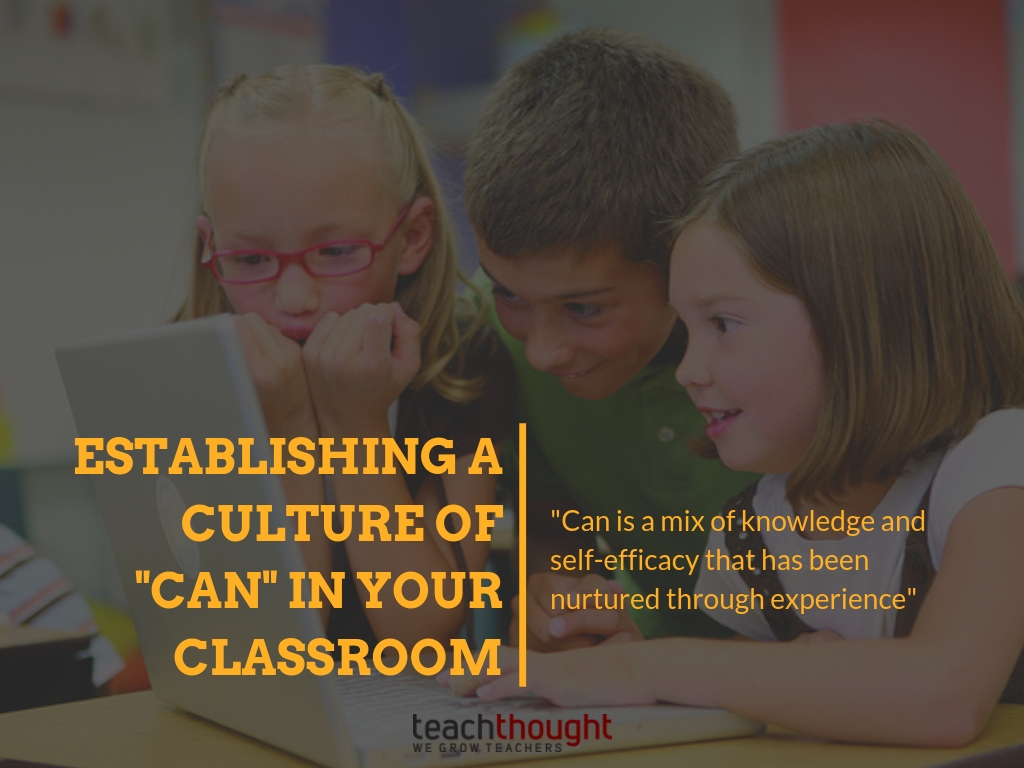

by Terry Heick
The long-term output of any faculty ought to be not simply proficient college students, however enabled learners. An “enabled” learner can grasp macro views, uncover micro particulars, ask questions, plan for brand spanking new information and switch considering throughout divergent circumstances. This doesn’t occur by content material “information holding,” and even by the fireplace of enthusiasm, however by setting a tone for studying that means chance, and by making a tradition of can.
First, it’s vital to understand {that a} “tradition” is comprised of tangible components (college students) and intangible components (curiosity). Additionally it is ever-present — it exists whether or not or not we as educators acknowledge it. It precedes formal studying and can final lengthy after that formal studying expertise has handed.
Studying “I Can”
If a learner is to develop a way of can, she or he should study it. Whereas some college students have extra pure confidence or initiative than others, can is barely totally different than confidence. Can is a mixture of information and self-efficacy that has been nurtured by means of expertise — by persistently assembly each internally and externally created objectives judged by requirements which can be additionally each internally and externally drawn.
So how does this occur? The place does it come from?
In Creating Minds, a type of anthology of the way to show considering edited by Artwork Costa, there are recommendations for selling cognition and metacognition, together with “making a secure setting,” “following college students’ considering,” and “educating questions somewhat than solutions.”1
These recommendations typically have emotional roots, implying that studying should be emotional (an implication that’s onerous to get away from). One broad strategy to educating that works practically each single time — and might work right here as effectively in making a tradition of can — is the gradual launch of accountability mannequin.
Three Methods to Create “Can”
1. Use the Gradual Launch of Duty MannequinThe gradual launch of accountability mannequin may be neatly summarized as “present me, assist me, let me.” This funnels learner participation from a teacher-supported function of statement to a collaborative function with a “extra educated different,” and at last to a task of independence that’s hopefully sustained.
By definition, this sample begins every time with the trainer in management, and ends with the expectation that the learner will assume management. It doesn’t throw learners into the deep finish to handle the applying of expertise and ideas they aren’t prepared for, however somewhat locations the burden on the trainer to expertly mannequin concepts and observe — and additional, to view the tip results of the educational course of as an in-control, unbiased doer.
2. Deliberately Use the Particular person Scholar as a Tradition-Maker
College students collect individually to create a bigger tradition. Habits modeled at school, the tone of important discussions, the temper of collaborative assignments and the relative ambition of initiatives and educational work all contribute to the tradition of a classroom. If this tradition comes from the highest down, it finally ends up being extra discuss and “expectation” than precise tradition. Tradition is natural and practically not possible to impose — however it may be nurtured and grown.
Honoring the contribution of learners is a important issue. That is totally different than acknowledging their achievement, which may be both educational or patronizing. Contributions, nevertheless, contain nuance — supporting roles, emotional help, mini-milestones in long-term initiatives, and different “minor” actions.
The truth is, there may be extra nuance right here than any trainer with 35 college students may ever presumably discover the time to focus on. However as you make a observe of stating, highlighting and in any other case drawing consideration to those actions and cognitive conduct, you’ll finally see the opposite college students doing the identical.
And when that occurs, you’re creating tradition!
3. Numerous — and Genuine — Phrases for Success
No one desires a well-intentioned ribbon for participation, however developing with genuine phrases for fulfillment in studying could make or break an expertise for a kid.
The extra numerous the studying and writing, the extra selection constructed into the challenge, the extra self-designed the rubrics, the extra “self-published” the multimedia, the extra genuine the success. We’ve (hopefully) moved past strict “lecturers” the place the trainer dictates the objectives, area and “finish recreation” phrases, and moved to a spot that’s actually learner-centered, a spot the place college students received’t make superficial choices that hardly alter the course of studying, however somewhat set up their very own causes to study, their very own requirements for high quality and their very own metrics for fulfillment.
That is the muse for a tradition of can.
1Page 12-13, Creating Minds: A Useful resource E-book for Educating Considering. “Considering in Context: Educating for Open-Mindedness and Vital Understanding.”
2A reference to Lev Vygotsky‘s relative time period that identifies the “information holder” in a studying course of.
Picture attribution flickr person luciellaribiero; Establishing A Tradition Of “Can” In Your Classroom; this text was written by Terry Heick and initially printed on edutopia.org



